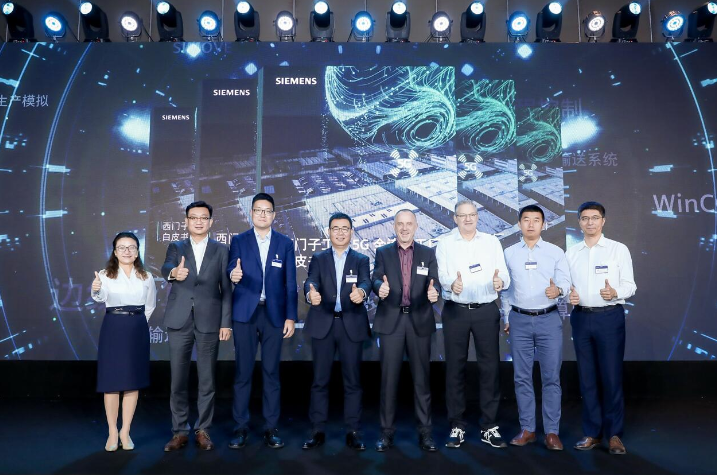Siemens recently released the "Siemens Industrial 5G Fully Connected Factory White Paper" (hereinafter referred to as the "White paper") during the 2023 Siemens Electronics Industry Customer High-end Forum, combining the evolution of 5G technology application environment and market demand, and combing its own successful practice of exploring 5G application in the industrial field. By interpreting Siemens' application cases in the automotive, logistics, steel, electronics, food and beverage industries, the white paper deeply analyzes how Siemens combines its own cutting-edge technology and mature ecology with 5G network, and provides guidance for industrial 5G to land in more industries.

"As a future-oriented technology, industrial 5G is not only the key infrastructure for building smart factories, but also creates more possibilities for the scale application of key technologies such as artificial intelligence and edge computing." With the acceleration of the large-scale application of 5G technology, how to explore more application scenarios has become the top priority of industrial 5G development." Wang Haibin, executive vice president of Siemens (China) Co., LTD., and general manager of Siemens Greater China Digital Industry Group, said, "In this white paper, Siemens summarizes its own key technologies and industry experience in the field of industrial 5G, providing knowledge and experience for the implementation of 5G technology in thousands of industries. In the future, we look forward to working with more Chinese industry partners to tap the huge potential of 5G fully connected factories and jointly paint an exciting new industrial picture of the future."
5G is integrated with digital technology to realize data-driven production in all aspects
The white paper reviews the achievements of Siemens, one of the leading companies in the field of industrial communications, in the development of the industrial 5G product portfolio and related solutions. In 2022, Siemens officially launched the industrial 5G solution for the Chinese market, providing secure, high-speed and flexible industrial 5G end-to-end communication. Through Siemens Industrial 5G support industrial protocol transmission, the control PLC can achieve PROFINET communication with the industrial field I/O module, so that more and more industrial field equipment can be interconnected through industrial 5G, and realize the comprehensive monitoring of massive data in the whole plant, automatic control of production lines, accurate scheduling of mobile equipment, ultra-remote system debugging and fault diagnosis and other applications.
Siemens' advanced digital technology combined with 5G can further accelerate the transformation and upgrading of data-driven production and operations, and help Chinese industrial enterprises improve their digital level. For example, the integration of 5G and PROFINET can establish an open industrial automation network ecology, and better realize the integration of IT and OI; The combination of 5G and Siemens edge computing can build an industry-oriented local ecosystem with deep integration at the architecture layer, deployment layer and scheduling layer to better meet the network, computing and data processing needs in the factory. Taking advantage of 5G's low latency and high reliability, Siemens Energy management systems can upload energy consumption data to enterprise digital platforms faster and more securely, helping enterprises achieve sustainable development.
Focus on seven application scenarios and deepen more industry tracks
Siemens has not only created industrial 5G solutions that are real-time, secure, support industrial protocols, and compatible with Siemens hardware and software products, but also actively opened up new industry tracks and customized application solutions for more industry customers. Starting from the whole process of factory production management, the white paper selects seven typical application scenarios of 5G+ fieldbus full connection, 5G+ remote, 5G+ data acquisition, 5G+ intelligent logistics, 5G+ energy management, 5G+ production simulation, and 5G+ edge computing, and details the specific applications of Siemens Industry 5G in different industries through specific application cases.
In the automotive industry, Siemens deployed an industrial 5G terminal on an electric monorail transport system (EMS) trolley to achieve real-time, secure communication between the trolley and the ground master controller, and compared with the traditional way, reduced hardware laying, significantly reduced costs, reduced maintenance difficulties, and simplified equipment space layout. In the airport industry, Siemens 5G technology meets the remote, efficient and reliable transmission of airport equipment control signals, multi-channel video and other information with the characteristics of high bandwidth, low delay and strong connection, helping to build a digital and unmanned "smart airport". In the food and beverage industry, the realization of 5G large bandwidth wireless coverage in the factory can improve the communication capacity, help realize the full traceability of raw materials, product manufacturing intelligence, product customization precision and cold chain logistics convenience, and accelerate the digital transformation process of the food and beverage industry.
With the power of digitalization to drive the future of the industry, Siemens Electronics Day came to a successful end
The 2023 Siemens Electronics Industry Customer High-end Forum with the theme of "Digital intelligence dual drive, Shaping the Future together" was successfully held in Shenzhen. Through keynote speeches, white paper releases and symposiums, Siemens shared cutting-edge insights on the development of China's electronics industry and comprehensively demonstrated how its digital technologies and solutions enable high-quality and sustainable development of the electronics industry. During the forum, Siemens also had in-depth exchanges with various partners in the electronics industry, and worked together to create a new ecology of cooperation in the electronics industry through technology sharing and cooperation.